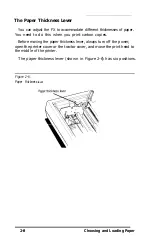
The decimal system is the standard numbering system based on units
of ten, using the numerals O-9.
The hexadecimal, or hex, system is based on units of 16 and is often
used by programmers. Instead of using only the numerals 0 through 9,
the hex system also uses the letters A through F. For example, the
decimal numbers 9, 10, 11, and 12 are 09, 0A, 0B, and 0C in hex.
Since the most frequently used hexadecimal numbers are between 0
and FF hex (0 to 255 in decimal), it’s common to write hexadecimal
numbers that are less than 16 with a zero in front, as shown above.
In this book, hex numbers are distinguished from decimal numbers
by the word hex after them (for example, 1B hex). Other common
ways of denoting a hexadecimal number are the following:
1BH $1B &1B &HlB
<1B>H
The Command Summary and the Quick Reference card give both
the decimal and hex numbers for each command.
Word Processors
In many ways, word processors demand the most from your printer.
When you create and print a document, you may use many print styles
and fonts, add headers and footers, and use bold, italic, and other
effects.
Once you have installed your word processor by using the lists on
page 3-1, you can ordinarily use a fixed set of printer features by using
a word processor command to place markers around the text to be
altered. When the document is printed, the markers are recognized and
translated into suitable commands for your printer. On your screen
some programs show the markers; others display the text as it will
appear-for example, in bold or italics.
This method is normally restricted to features that can be found on
almost all printers, such as bold and underlining.
Some programs also provide a way of placing complete printer
commands in the text. These commands may or may not be visible on
your screen. This method has the advantage of allowing you to use any
printer command, not just a limited set. To make use of it, however,
you need to understand how to use the printer’s commands.
Using the FX with Application Programs
3-3
















































